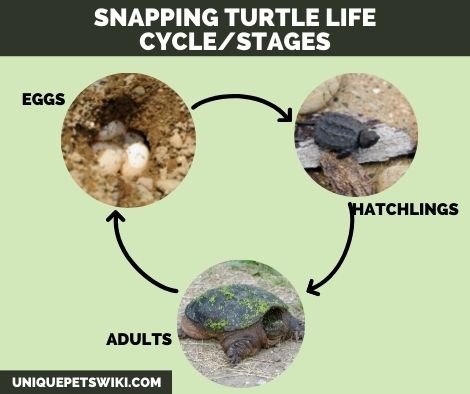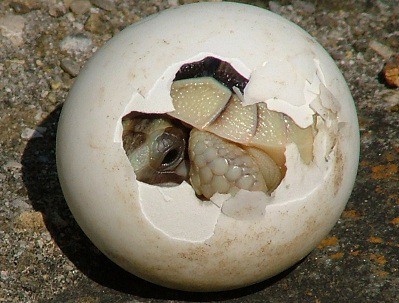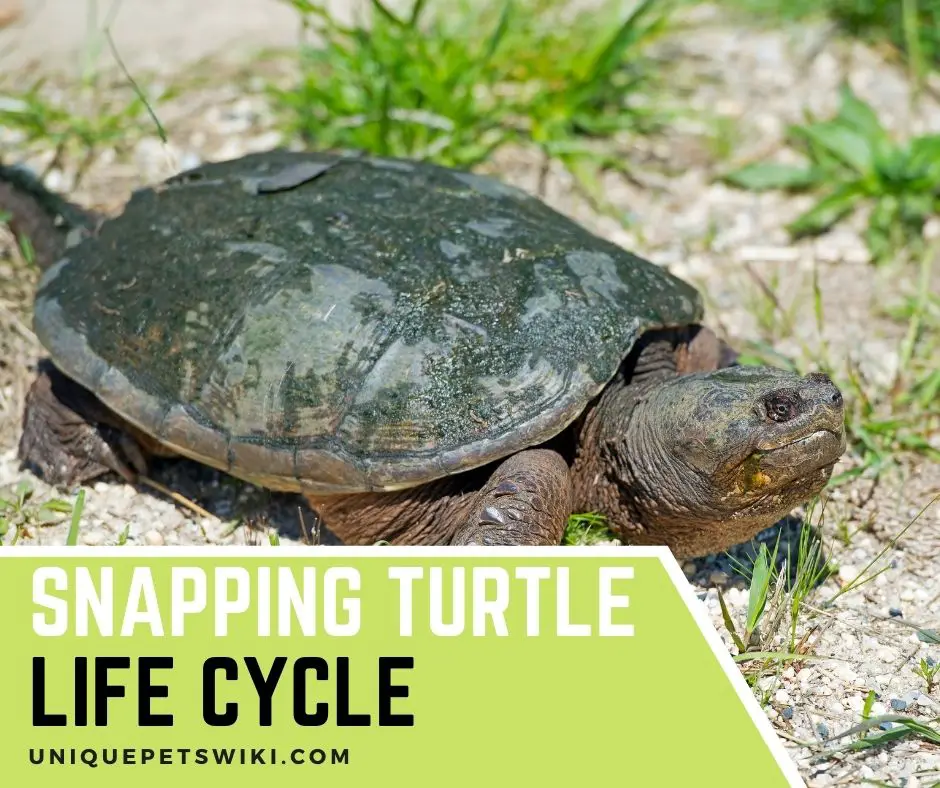Every living thing, both plants and animals have a cycle of life that basically revolves around birth, infant/seedling, and adulthood/maturity. In the case of a snapping turtle life cycle and stages, its life revolves around three stages of “fertilized egg, hatchling and adulthood”.
Besides snapping turtles, other species of turtles both sea and land turtles also follow this same life cycle of “fertilized egg, hatchling and adulthood or maturity. Since every turtle species has a different environment in which they live, what happens in each of these three life stages differs among the animals.
What season of the year they mate, fertilize the eggs, become gravid, lay eggs, and how long it takes the eggs to hatch into hatchlings and subsequently adults are all a factor of their individual species and habitat.
In this article, the focus will be on the snapping turtle species. What time of the year do they mate? How long does it take before they lay their eggs? How long does it take the eggs to hatch and grow to adults? What happens at each of the life stages?
All these questions and many more will be answered in the article. Keep reading!
Contents
Information About Snapping Turtles
Snapping turtles are one of the most fascinating turtle species kept as pets for the past centuries. Unlike other breeds of pets such as dogs and cats, they are not just hardy and require less attention, but are also docile and easy to care for as pets.
Physically, snapping turtles are very easy to identify from other species of turtles. Snapping turtles have a characteristic bulky head, large body size, and extremely long and flexible neck of about 19 inches long capable of turning in any direction with which they use to defend themselves when faced with danger.

They are large in size with varying shell colors of tan, dark brown, and black. Unlike other species of sea turtles and tortoises with a large carapace (shell), snapping turtles have a nearly flat carapace, small plastron, short pointed snout, and sharp hooked beak.
For snapping turtles, the abundance or absence of a physical feature tells us why they behave the way they do in the wild. Since they don’t have large carapaces and plastrons that they can tuck themselves in during danger, they tend to act aggressively and use their long necks and sharp beaks to snap at predators when faced with danger.
Geographically, snapping turtles are native only to North America spanning across Central Texas, Northern Mexico to the Rocky Mountains, and Florida. In these regions, they have their habitat in slow-moving freshwater bodies such as lakes, streams, ponds, creeks, or rivers.
Being aquatic animals, snapping turtles enjoy burrowing in the muddy bottom of their habitat in the wild. But in captivity, replicating a muddy habitat isn’t necessary. This will only make clean-up difficult for you as a keeper.
Life Cycle Of A Snapping Turtle: What Is The Life Cycle Of A Snapping Turtle?
The life cycle of snapping turtles or any animal is the time from when the animal is born, the growth process, maturity, reproduction and death of that animal. In the case of snapping turtles, it revolves around “eggs-hatchlings-adult”.

Keeping a snapping turtle or any other turtle species as a pet is a long time commitment. Depending on when you got it as a pet and at what age you both were, you will definitely grow into old age with your pet.
Besides, since the actual gestation period of snapping turtles is not known, it is important for you to know the life cycle of these animals and what to expect or do at each stage to ensure the continuity of these animals.
As stated earlier, snapping turtles as well as other species of turtles have three basic life cycles of “fertilized egg-hatchling-adulthood” and their life begins when they hatch from the eggs. In this section, we’ll expound on each stage for your understanding.
Mating
Before an egg can be formed that will hatch as a snapping turtle, mating must have taken place some months prior to fertilization. This usually occurs between April and November after which the female snapping turtle will become active in breeding during the warmer months.
It is important to state here that female snapping turtles can store sperm and even fertilized eggs in their body for as long as three years till when they are ready to lay the eggs.
For this reason, the gestation period isn’t known in snapping turtles because it’s difficult to measure or tell when the female’s eggs were fertilized by the sperm she stores in her body.
However, to help determine if your pet snapping turtle is gravid and ready to lay eggs, keepers are always advised to keep a close watch on their pet for changes in their behavior, especially if she had been introduced to a male or mated.
Nesting And Egg-Laying
In the wild, when gravid female snapping turtles are ready to lay their eggs in the warmer months, they usually leave the water body to dig a nest for their eggs on land. The nests are usually some miles away from a freshwater body and about 5 to 7 inches deep and 2 to 3 inches wide.
The reason for digging a nest a few miles closer to a water source is so that it will be easy for the hatchlings to locate the nearest water body when they hatch before a predator can prey on them since female snappers don’t care for their young.
However, even at that, snapping turtle eggs and hatchlings hardly survived till adulthood without being preyed on. Having understood that the chances of survival for her eggs and hatchlings are low, the female snapping turtles lay large clutches of eggs in a single birth to help increase the hatchlings’ chances of living.

Egg Hatches
When the female snapping turtle had finished laying her clutch, she would cover it up with sand and leave without returning to check on the eggs. Within a period of 3 – 4 months (90 – 120 days) the buried (incubated) eggs will begin to hatch.
In the wild, incubation is done naturally and it’s made possible by the temperature of the environment. The environmental temperature not only incubates the eggs but also determines how fast or slow the eggs will hatch as well as the sex of the hatchlings. The hotter the temperature (environment) the faster the eggs will hatch and vice versa.
That notwithstanding, all snapping turtle eggs do not hatch at the same time, and when the eggs finally hatch, they don’t leave the eggshell until after a few days. Hence, you must adhere to all precautions when handling your snapping turtle eggs.
To learn more, read about How To Hatch Your Snapping Turtle Eggs.

Early Life (Baby And Juvenile)
Life for a snapping turtle begins when the hatchling cracks open the eggshell with its egg tooth. Hatchling snapping turtles emerge from the eggshell about an inch long and may vary in shell color. Some hatchlings may emerge with brown, tan, olive, or black shell colors.
As they come out of the shell, they still have the egg sac stuck to them on their stomach. The sac usually is yellowish-orange in color and it contains some egg yolk which is what the hatchlings will survive on till they can locate nearby water in the wild.
Therefore, for your captive snapper hatchlings, do not remove the hatchling from the sac as this will predispose them to infection and may even cause death. Also, while the sac is still on the hatchlings, do not feed them until the sac is completely gone off.
A newly hatch snapping turtle is a hatchling only for the first few weeks, after which it becomes a baby snapper and juvenile till it gets to adulthood in 4 to 7 years.
During this period, the juvenile snapper feeds more on animal protein such as crayfish, shrimps, and worms than on vegetables. This is because they need protein, calcium, vitamins, and minerals in large amounts for their growth.

Full Grown Adults
The next phase/stage in a snapping turtle’s life cycle is the adulthood stage and this phase lasts till they die. Once the female snapper lays some eggs and they hatch into hatchlings, it takes about 4 to 7 years for the hatchlings to grow to sexual maturity.
How long exactly depends on the sex of the turtle. Female snapping turtle hatchlings reach sexual maturity later in years than the males. It takes a male hatchling 5 years to attain sexual maturity, while a female hatchling will attain maturity between 4 to 7 years.
Within these periods, the hatchlings are predisposed to lots of danger and only a very few do survive to sexual maturity. Some are either preyed on or trampled by other animals.
As adults, snapping turtles measure about 6 inches long. At this stage also, their body features such as the beak, tail, and jaws become more pronounced and the color of their carapace becomes deeper and vibrant.
Sex Determination Of A Snapping Turtle
Snapping turtles and reptiles, in general, don’t have chromosomes as humans do. Hence, the sex of their offspring is externally determined by their environment rather than by them. They don’t have any control or contribution to the sex of their offspring.
In the case of snapping turtles, the temperature of the environment as of when the eggs were incubated determines the sex of the hatchlings.
Female snapping turtles are hatched at a higher temperature range of 73⁰ F – 75⁰ F while males are hatched at a cooler temperature of 68⁰ F. A moderate temperature of 74⁰ F will produce hatchlings of both sexes. That is, some eggs will hatch as males and some as females.
How Long Does A Snapping Turtle Live? The Average Lifespan
On average, both in captivity and the wild, snapping turtles live for 30 years. Wild adult snapping turtles do not have as many predators as the hatchlings. As noted earlier, the hatchlings barely make it to sexual maturity without being preyed on. However, once they (hatchlings) manage to escape that phase, they can live up to 30 years.
In captivity, snapping turtles tend to live longer than the average lifespan in the wild since there are no predators to shorten their lifespan. But this of course is subject to quality husbandry and good habitat setup.
Even with no predators in captivity, poor husbandry and poor habitat setup have been the major causes of shorter lifespan in captive snappers. Nonetheless, as a keeper, if your husbandry is optimal together with an appropriate habitat, your pet snappers can live up to 50 years and more.
Wrapping Up
Snapping turtles as well as other species of turtles have a life cycle similar to humans, but only that they have to face a different set of obstacles to survive each phase.
Fortunately for snapping turtles, they are not born helpless as humans. They are born with survival instincts that helped them to survive the first few weeks and all through their lives.
But even at that, they are still at risk of being killed by hungry predators or trampled on by other animals before they could make it to a water body.
In this article, we have outlined the three basic stages in the life cycles of snapping turtles and what happens in each of these stages.
As a good keeper, we hope that you understand how delicate these animals are and how important it is that you provide them with the appropriate environment to live a healthy life.
